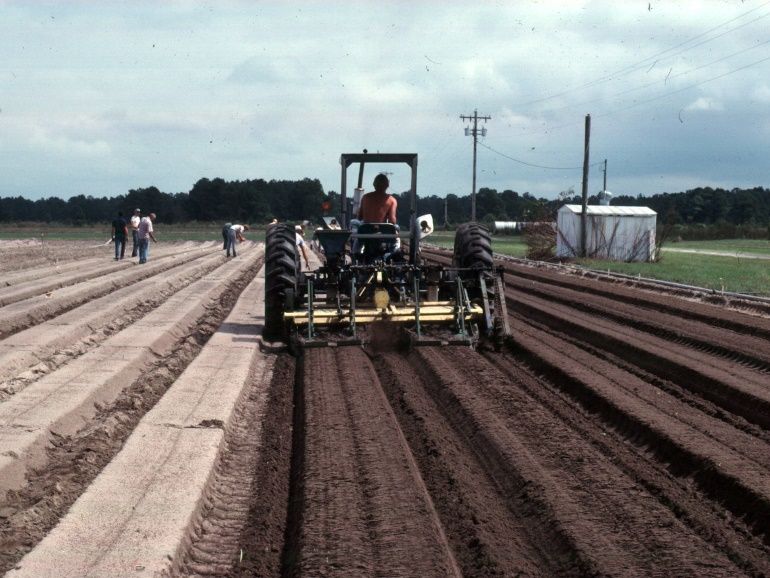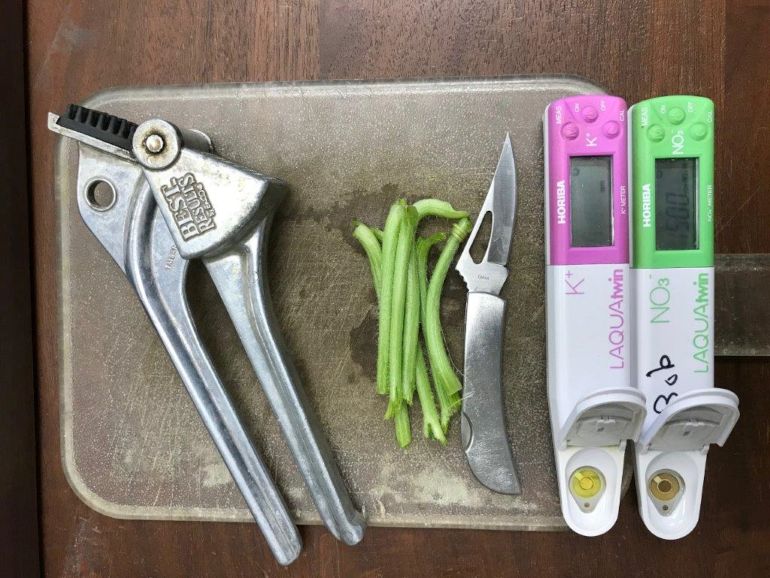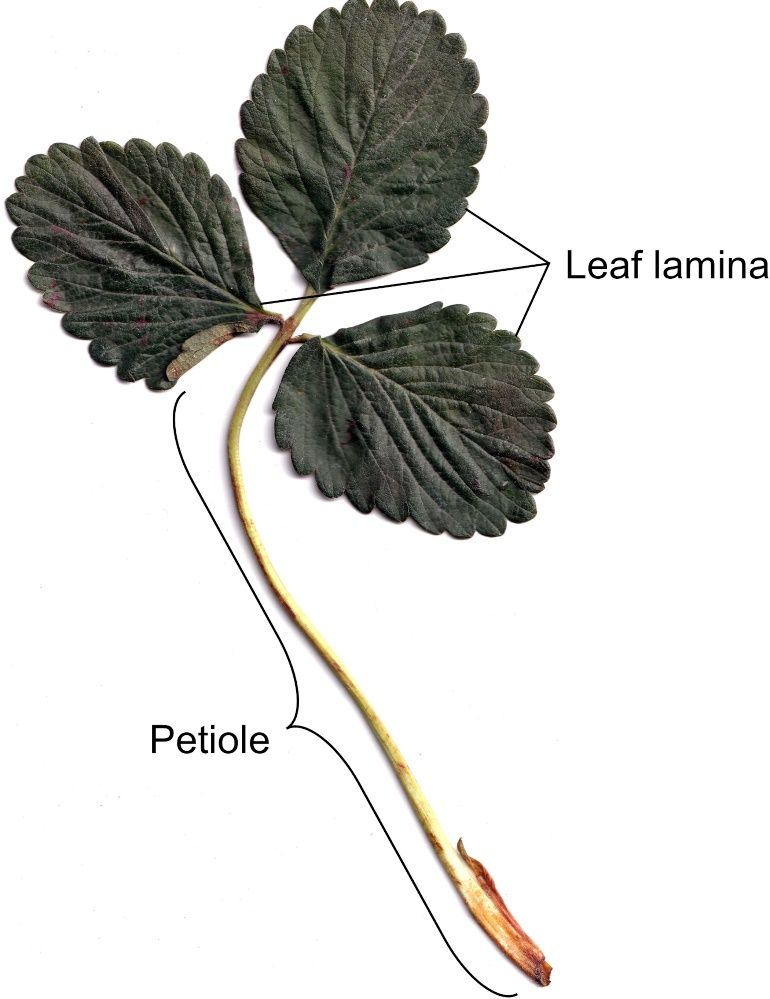Introduction
Strawberry is an important specialty crop in Florida, produced as an annual crop on plastic-mulched beds with drip irrigation. The main production area is in west-central Florida, including Hillsborough, Polk, and Manatee counties. Fertilizers are becoming a more significant portion of strawberry production costs; hence, proper fertilizer management is important for minimizing production costs and maximizing yield and fruit quality, while minimizing potential negative impacts on the environment caused by leaching or runoff of excess fertilizer nutrients. This guide summarizes the recent history of strawberry fertilization research and presents the updated research-based fertilizer management recommendations for strawberry production in Florida. The intended audience for this article includes growers, certified crop advisors, crop consultants, and county extension faculty.
Fertilization Recommendations
Preplant Fertilization: Phosphorus, Potassium, Magnesium, and Calcium
Strawberry phosphorus (P) and potassium (K) fertilization recommendations are based on the calibrated Mehlich-3 soil test results and vary according to the soil-test P and K levels (Table 1). A portion of the recommended K amount (20%–25%) may be incorporated in the bed through a preplant application (Figure 1). Rates of K higher than recommended reduced average strawberry fruit size and yield (Albregts, Howard, and Chandler, 1991; Albregts et al., 1994). Similarly, a portion of the recommended P and magnesium (Mg) amounts can be incorporated through a preplant application. It has been observed that strawberries can be grown successfully only with post-planting fertigation. To minimize the risk of nutrient leaching or runoff, growers are encouraged to use controlled-release or slow-release fertilizers for pre-plant fertilization. Typically, calcium (Ca) fertilization is not needed because the soil holds enough Ca at recommended pH levels, and irrigation water contains Ca that plants can use.

Credit: G. Hochmuth, UF/IFAS
Preplant Fertilization: Nitrogen and Sulfur
Research studies revealed that early or season-long strawberry yields did not respond to preplant nitrogen (N) (Agehara, Santos, and Whidden, 2007) when early season N fertilization was optimal. Additional, recent studies on strawberry have shown that early and total yields increased only marginally, or not at all, with preplant N at 50 lb N/acre. The work documented a stronger advantage to including preplant sulfur at about 30 to 50 lb S/acre (Santos, 2010).
The studies on preplant and early season N demonstrated that preplant N is not required for the optimal establishment or early or total yields of a strawberry plant, as long as appropriate fertigation rates are used early in the season (see “Nitrogen Fertigation” below). Growers considering applying preplant N are strongly encouraged to use controlled-release fertilizers.
Fertigation
Applying fertilizers through drip irrigation (fertigation) can increase the efficiency of leachable nutrients such as N and K (Locascio and Myers, 1975; Locascio and Martin, 1985). With fertigation, N and K can be applied during the growing season in small amounts that correspond to the crop’s N and K requirements.
Nitrogen Fertigation
Agehara (2021) demonstrated that (1) cultivars differed in their response to early season (mid-October to mid-December) N fertilization regimes and (2) strawberry plants need high rates of injected N during the early season period—i.e., within the first 21 days after discontinuing plant establishment irrigation—when preplant N is not used. Early season N management has season-long impacts on fruit yield and quality. When no preplant N was used, ‘Florida Radiance’ responded to high rates of early season N (about 2.0 lb N/acre/day), and ‘Florida 127’ responded to only about 1.5 lb N/acre/day (Agehara, 2021). In another study on ‘Florida Radiance,’ Agehara and Nunes (2021) evaluated three N rates (1.0, 1.5, and 2.0 lb N/acre/day) over 21 days during the early vegetative growth stage. Thereafter, all plants received 1.0 lb N/acre/day for the remainder of the season. Increasing N rate from 1.0 to 1.5 or 2.0 lb N/acre/day increased marketable yields by 15% to 18%. The whole season’s N amount was about 175 lb/acre. In an earlier study without preplant N, strawberry cultivars ‘Strawberry Festival’ and ‘Winter Dawn’ responded differently to seasonal N injection rates (Santos and Chandler, 2009). ‘Strawberry Festival’ yield increased as N rate increased from 0.5 to 0.8 lb N/acre/day, but ‘Winter Dawn’ yield did not.
The research above shows that, when no preplant N is used, early season injected N rates need to be about 1.5 to 2.0 lb N/acre/day, depending on the variety. Some varieties—those that may become too vegetative with high rates of N (e.g., Sensation™ ‘Florida127’)—would require less.
The IFAS total seasonal N recommendation has been about 150 lb/acre for a 150-day season (Mylavarapu, Hochmuth, and Liu, 2022); this new publication updates that recommendation. The new recommended target N amount is 175 lb/acre. However, cultivars may require additional N, depending on the length of growing season, tissue testing, and leaching rainfall (Table 2). Some growers on high-organic matter or heavier soils may need less N. Growers should avoid the temptation to apply excess N because excess N can increase the amounts of malformed fruits (Albregts and Howard, 1982) and can lead to excessive vegetative plant growth, more disease pressure, and reduced fertilizer use efficiency. Excessive N late in the growing season may also lead to soft fruits that do not ship well. The revised seasonal N injection recommendations are presented in Table 2.
Fertigation Schedule
N and K can be injected on a daily to weekly basis. If injected weekly, cultivars should be given seven times the amount of nutrients administered per day on the daily schedule. The weekly injection will work as long as the field is not excessively irrigated; excessive irrigation leaches the soil of its nutrients. Schedules for N and K injection and plant tissue testing were evaluated for strawberries (Albregts et al., 1994; Hochmuth et al., 1996). Fertilizer N and K recommendations in this guide (Table 2) have been updated considering the latest research on newer varieties.
Irrigation Management
All strawberry crops in Florida are now irrigated with drip irrigation systems. Although drip irrigation can improve irrigation efficiency, care must be exercised to operate the system properly so optimum amounts of water are applied. Inadequate irrigation can reduce yields, and over-irrigation can leach N and K. Irrigation amounts should be scheduled to meet strawberry crop evapotranspiration needs—ranging from 800 gal/acre/day in October to 3000 gal/acre/day in March/April. Growers should monitor rainfall and apply the leaching-rain rule amounts of N (up to 30 lb N/acre if rainfall is >3 inches in 3 days or >4 inches in 7 days). The amount should be spaced over 7 to 10 days. Soil moisture sensors are recommended to help manage the irrigation program and minimize soil nutrient leaching. Growers wishing to reduce seasonal N rate should review their irrigation program and investigate soil moisture sensors.
Petiole Sap Testing
Making a timely analysis of plant tissue N and K can help optimize N and K injection and can aid farmers in making quick decisions on how much N and K to inject. Using data from research studies and commercial strawberry farms, extension scientists developed petiole sap testing procedures (Figure 2). The petiole sap sufficiency ranges for N and K for strawberry are presented in Table 3. More information on petiole sap testing can be found in “Guide for Plant Petiole Sap-Testing for Vegetable Crops” (Hochmuth and Hochmuth, 2022).

Credit: R. Hochmuth, UF/IFAS
Whole-Leaf Testing
Petiole sap analyses should be backed up by periodic analyses of whole leaves by an analytical laboratory (Figure 3). Sap testing is most useful for N and K because procedures and critical test levels have not been developed for other nutrients. Sufficiency ranges for nutrients in whole strawberry leaves are presented in Table 4.

Credit: S. Agehara, UF/IFAS
Checklist for Successful Strawberry Drip Fertigation
- Conduct preseason soil testing to determine lime and fertilizer requirements.
- Preplant N and K fertilization is not needed. Follow the growth stage-specific recommended rates in Table 2.
- Begin N and K injections as soon as the plant establishment irrigation is discontinued, typically 2 weeks after planting, where no preplant N or K were used.
- Practice careful irrigation management to avoid over-irrigation which leaches N and K from the root zone. Use soil moisture sensors.
- Inject N and K on a daily to weekly basis at rates according to the recommendations presented in Table 2.
- Monitor petiole sap N and K concentrations and use that information to adjust N and K injection schedules or rates. Back up petiole sap-testing with laboratory analyses of whole leaves. Regular tissue testing can help minimize overfertilization.
- Monitor rainfall and apply leaching-rain rule amounts of N (up to 30 lb N/acre if rainfall is >3 inches in 3 days or >4 inches in 7 days).
References
Agehara, S. 2021. “Characterizing Early-Season Nitrogen Fertilization Rate Effects on Growth, Yield, and Quality of Strawberry.” Agronomy 11 (1): 905. https://doi.org/10.3390/agronomy11050905.
Agehara, S., and M. C. N. Nunes. 2021. “Seasonal and Nitrogen Fertilization Effects on Yield and Physiochemical Attributes of Strawberry under Subtropical Climate Conditions.” Agronomy 11 (7):1391. https://doi.org/10.3390/agronomy11071391.
Agehara, S., B. M. Santos, and A. J. Whidden. 2007 (updated 2017). “Nitrogen Fertilization of Strawberry Cultivars: Is Preplant Starter Fertilizer Needed? HS1116/HS370, 8/2007.” EDIS 2007 (19). https://doi.org/10.32473/edis-hs370-2007.
Albregts, E. E., G. J. Hochmuth, C. K. Chandler, J. Cornell, and J. Harrison. 1996. “Potassium Fertigation Requirements of Drip Irrigated Strawberry.” Journal of the American Society of Horticultural Sciences 121 (1): 164–168. https://doi.org/10.21273/JASHS.121.1.164.
Albregts, E. E., and C. M. Howard. 1982. “Effect of Fertilizer Rate on Number of Malformed Strawberry Fruit.” Proc. Fla. State Hort. Soc. 95: 323–324.
Albregts, E. E., C. M. Howard, and C. K. Chandler. 1991. “Strawberry Responses to K Rate on a Fine Sand Soil.” HortScience 26 (2): 135–138. https://doi.org/10.21273/HORTSCI.26.2.135.
Hochmuth, G., and R. Hochmuth. 2022. “Plant Petiole Sap-Testing for Vegetable Crops: CV004/CIR1144, Rev. 5/2022.” EDIS 2022 (3). https://doi.org/10.32473/edis-cv004-2022.
Hochmuth, G. J., E. E. Albregts, C. C. Chandler, J. Cornell, and J. Harrison. 1996. “Nitrogen Fertigation Requirements of Drip-Irrigated Strawberries.” Journal of the American Society of Horticultural Science 121 (4): 660–665. https://journals.ashs.org/jashs/downloadpdf/journals/jashs/121/4/article-p660.xml.
Hochmuth, G. J., D. N. Maynard, C. S. Vavrina, E. A. Hanlon, and E. Simonne. 2022. “Plant Tissue Analysis and Interpretation for Vegetable Crops in Florida: HS964/EP081 Rev. 11/2022.” EDIS 2012 (10). https://edis.ifas.ufl.edu/publication/EP081.
Locascio, S. J., and F. G. Martin. 1985. “Nitrogen Source and Application Timing for Trickle-Irrigated Strawberries.” Journal of the American Society of Horticultural Science 110 (6): 820–823. https://doi.org/10.21273/JASHS.110.6.820.
Locascio, S. J., and J. M. Myers. 1975. “Trickle Irrigation and Fertilization Method for Strawberries.” Proc. Fla. State Hort. Soc. 88: 185–189.
Myers, J. M., and S. J. Locascio. 1972. “Efficiency of Irrigation Methods for Strawberries.” Proc. Fla. State Hort. Soc. 85: 114–117. https://journals.flvc.org/fshs/article/download/98978/94964.
Mylavarapu, R., G. Hochmuth, and G. Liu. 2022. “UF/IFAS standardized nutrient recommendations for vegetable crop production in Florida: CIR1152/CV002, Rev. 12/2021.” EDIS 2021 (6). https://doi.org/10.32473/edis-cv002-2021.
Santos, B. M., and C. K. Chandler. 2009. “Influence of N Fertilization Rates on the Performance of Strawberry Cultivars.” International Journal of Fruit Science 9 (2): 126–135. https://doi.org/10.1080/15538360902991337.
Santos, B. M. 2010. “Effects of Preplant Nitrogen and Sulfur Fertilizer Sources on Strawberry.” HortTechnology 20 (1): 193–196. https://doi.org/10.21273/HORTTECH.20.1.193.
Table 1. Interpretation of Mehlich-3 soil P and K for fertilizer recommendations for strawberry (Mylavarapu et al., 2022).
Table 2. N and K fertigation recommendations for strawberry in Florida.1
Table 3. Sufficiency ranges for petiole sap nitrate–N (NO3–N) and K concentrations for strawberry: October planting (Hochmuth and Hochmuth, 2022).
Table 4. Sufficiency nutrient ranges in most-recently-matured whole leaves (blade plus petioles) of strawberry (Hochmuth et al., 2022).